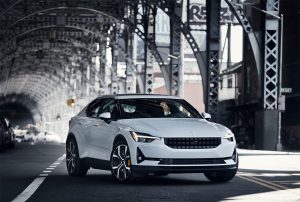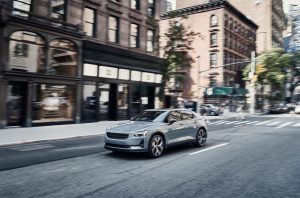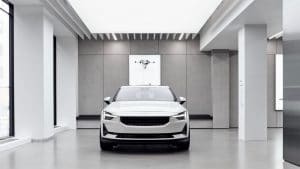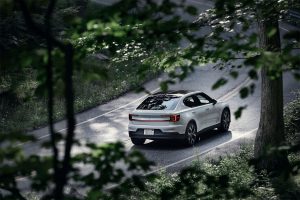
Polestar Two will be the brand’s first fully electric vehicle and is expected to be the volume model.
Head to Google and search terms like “Tesla fighter,” or “Tesla killer,” and you’ll get pages of results, some referencing comments from competing manufacturers, others the breathless expectations of journalists and analysts. The reality is Tesla continues to dominate the battery-car market. But plenty of competitors are ready to try their luck – even if they just pick up the scraps Tesla misses in a market expected to grow exponentially over the coming decade.
Among them is China’s Geely, an ambitious player marketing battery-cars through a variety of marques, including Chinese brand Lynk & Co., Volvo and, soon, the all-new Polestar. With its “pure progressive performance” mantra, Polestar isn’t aiming to be a mass market brand, but its aspirations are still significant, as company officials outlined during a Zoom conversation this week.
So far, the Swedish-based brand has introduced two all-new models, starting with the Polestar One, an extremely limited-run, $150,000 plug-in hybrid that will serve as the brand’s “halo car,” explained Polestar Chief Operating Officer Jonathan Goodman. The volume model is the Polestar Two, an all-electric crossover that shares the same basic CMA “architecture,” or platform as Volvo’s new XC40 – and which will roll down the same assembly line in Luzhou, a city in China’s Sichuan Province.
(Polestar set to open first U.S. dealership.)

The new Polestar Two and its hybrid sibling, Polestar One, is starting to roll into retail locations in China and Europe.
A number of other products are in the planning or development stage, but “Polestar One will be the only hybrid we’ll ever produce,” Goodman explained, adding that, going forward, all Polestar models will be “100% electric.”
And, as the brand mantra explains, they will add put a premium on performance. The Polestar One will punch out a combined 619 horsepower from its gas-electric driveline. The initial version of the Polestar Two, meanwhile, will make 408 hp from its twin electric motors, enough to launch it from 0 to 60 mph in about 4.5 seconds.
A lower-powered Tesla Model Y competitor will follow, and will be priced around $40,000, Goodman revealed, adding that as the line-up expands, “We will always have the performance derivatives first.”
Like Tesla and other competitors, Polestar planners have learned a critical lesson watching a number of first-generation BEVs flounder. While motorists might want more environmentally friendly technology, few are willing to make sacrifices to go green. They also expect longer range and one of the biggest selling points for an electric vehicle, it turns out, is the incredible, off-the-line torque that electric motors can deliver.

Polestar’s retail stores are called Spaces. In the U.S. there will initially be just two. One in California and one in New York.
“That jaw-dropping performance (is) “one of the key things,” along with “great design,” that Goodman expects to be critical for the new brand’s success.
(First Look: Polestar 2 goes all electric.)
Both Polestars One and Two are just starting to roll into showrooms or, as the startup prefers to call them, Polestar Spaces. Sales have just gotten underway in China, as well as Europe, and the first two U.S. outlets will be opened by the end of this month, one in Manhattan, the other in California. The goal is to be in nine countries this year – China, Switzerland, Norway, the Netherlands, Great Britain, Belgium, the U.S. and Canada – with 50 Spaces, including five in the States and three more north of the border.
The Volvo subsidiary is betting that EV buyers will want not only a different type of vehicle, but a different sales and service experience, as well. In Europe, showrooms will be small and, for the most part, set up alongside other “high street” retailers. Dealerships may be a bit more traditional looking in the States, but all will be standalone, said Goodman, even if they’re owned by retailers who also own a Volvo shop.
What’s more significant, is that Polestar will emphasize shopping in whatever form the customer wants. They’ll be welcome to drop into a dealership but, within the limits of state and local law, they’ll just as soon be able to complete the entire shopping process online, Goodman emphasized. Significantly, salespeople will be on salary, rather than commission, a strategy meant to encourage a lower-key process. And rather than load up dealer lots with stock, the focus will be on letting a buyer “order the car that (they) want.”

Polestar Two will make 408 hp from its twin electric motors, enough to launch it from 0 to 60 mph in about 4.5 seconds.
Meanwhile, “You’ll never have to cue up at a retailer for service,” the executive added, noting that all cars will be picked up, serviced and then washed before being returned to the owner.
Somewhat surprisingly, Polestar will not adopt the subscription model that has proved so popular with the Volvo XC40 – buyers paying a flat monthly fee that covers virtually everything, from the vehicle to service, taxes and even insurance. That may come later but plans have yet to be worked out, the COO explained.
Polestar might hope to grab onto its rival’s coattails, but company officials have no fantasy of becoming the next Tesla. While they hope to generate some reasonable volumes, they will be measured “in the tens of thousands, not hundreds of thousands,” said Goodman, at least initially.
(Volvo aiming for half its sales to be all electric by 2025.)
The EV market has proved a lot harder to crack than many had expected, even high-volume brands like Chevrolet, Ford and Audi, never mind Porsche and Jaguar, struggling to generate significant numbers. Whether Volvo can pull it off with Polestar remains to be seen, but the experiment is now underway.
